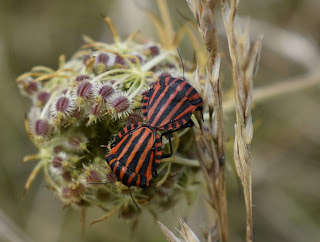 |
| Stunning shot of the Brown Booby |
The reported Brown Booby off Swalecliffe, Kent, on the 19 August was an exciting prospect. Could we really have such a mega seabird just 30 minutes up the road. Typically of seabirds, it did what seabirds do, and disappeared.
Fast forward to the 26 August and an apparent Brown Booby is seen near St Ives by bloke with no bins... Too good to be true? Thankfully not as Keith Jennings photographed a clear Brown Booby off Porthgwidden Beach. Seemingly settled in to a pattern around the St Ives bay, the challenge was clearly going to be one of timing - this bird wasn't going to give up easily. Showing on the 29 Aug, but not on the 30th, surely the report of one off the French coast (on the 30th) was the same bird...
On Saturday morning the bird was again seen in St Ives Bay and this time it did the honourable thing and sat on the rocks. Shortly after mid-day we departed with news the bird was still sat on the rocks - shortly after departing, but before taking our first blurred picture of Stonehenge, we heard it had taken off. But surely it was still in the area - we continued... Even news later in the afternoon that the bird was reported past Pendeen was nothing more than its usual daily ritual of feeding off Land's End...
A couple of beers later (and some sleep) and we were on site again - Sunday morning - a brisk NW wind blowing through my insufficient clothing. A no bird to be seen... We had dipped. Yet another blurred image of Stonehenge at 60mph...
Back in to the office on Monday - to be shaken by mega alert at 10:57am. The Brown Booby had been relocated at Kynance Cove near The Lizard - game on! Plans to return to Cornwall were considered whilst birders on site and viewing images considered this was a different bird to the St Ives individual - what? Surely not? There can't be two Brown Boobies in the NE Atlantic! Actually, as the French bird was an adult, surely there couldn't be three!
 |
| Third Stonehenge fly-past... |
Collected by John RHJS Clements at 5am and gathering Doug at 6am, we were taking our third Stonehenge image in four days before most people get to work: by 11.10am we were on site. Communications as they are these days, we could almost relax before seeing the bird - almost! National Trust car park ticket resolved (my membership card on me was typically three days out of date!) we sauntered down the amassed group of like-minded nutters to witness the almost unbelievable sighting of Britain's second, or just possibly third, Brown Booby!
Certainly though, Kynance Cove is beautiful. OK the weather was brilliant: OK we were excited at the prospect of seeing something special, but Kynance is lovely - simple as that!
The Brown Booby may be difficult to pick out though as it was a little way away...
However, aided by scopes and phones, the amazing sight of an immature Brown Booby in UK waters was now a reality. And after watching it for an hour or so, we did the right thing and departed to take our final picture of Stonehenge!
 |
| It was on this rock - honest! |























































